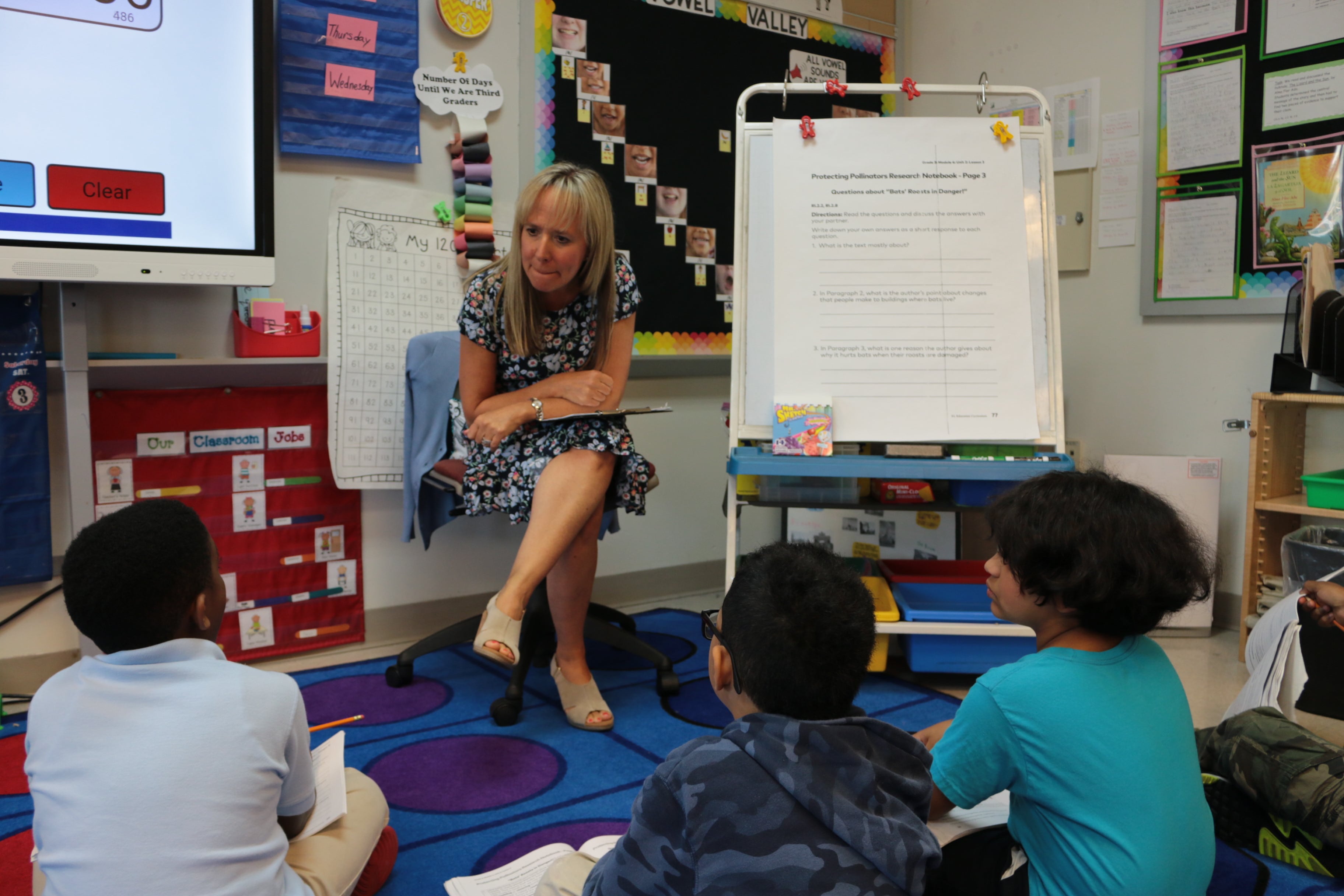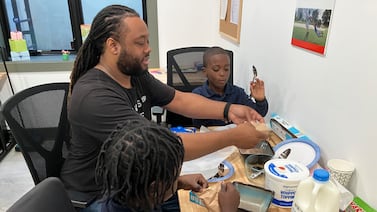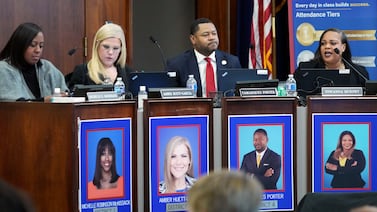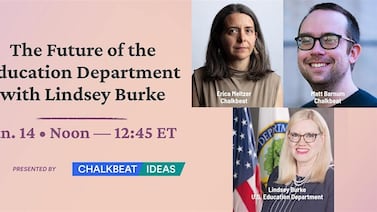Sign up for Chalkbeat’s free monthly newsletter How I Teach to get inspiration, news, and advice for — and from — educators.
Second grade teacher Janina Jarnich was focused on bats.
As her students gathered on the classroom rug one June morning, she instructed them to flip through their workbooks and take their “magic finger” to trace the words from an article about the nocturnal pollinators. Her students read aloud in unison about the dangers humans pose, from noises that interfere with bats’ sleep patterns to building renovations that can upend their roosts.
The lesson came from a curriculum called EL Education — one of three reading programs public elementary schools may use under a sweeping new mandate beginning this fall. All elementary schools in Bronx District 11 must now use EL Education, including Jarnich’s. But she has a head start: Her school, P.S. 169 Baychester Academy, has used the program for years.
The curriculum has won praise from advocates who say its focus on building students’ background knowledge on a range of topics will set them up to be strong readers. It also includes lots of opportunities for writing. But some educators note EL Education is dense with materials and can take time to unpack. So far, only one of the city’s districts out of the initial 15 covered by the mandate have selected the curriculum.
We recently caught up with Jarnich, a 26-year veteran of the city’s public schools, about how she approaches reading instruction, what sets EL Education apart, and what kind of training she wished he had.
How and when did you decide to become a teacher?
I was in my junior year of college and unsure of what I wanted for my career. I had originally wanted to be a veterinarian, but that was not working out. My mom was a NYC public school teacher, and my dad had just retired as a history professor from Queens College, so I decided to give teaching a try.
Literacy has taken center stage since Mayor Eric Adams announced a new reading curriculum mandate. What do you make of the renewed focus on how schools teach children to read?
I was very happy to hear about the new mandate. Teachers have known for a long time that the whole language approach and Lucy Calkins’ Teachers College readers workshops did not work for every child. Phonemic awareness and phonics are key for children to learn to read.
Your school already adopted EL Education, one of the three reading programs all elementary schools will be required to use. How would you describe that curriculum’s approach to a parent?
EL uses real fiction and nonfiction texts to teach real-world issues. There are four modules for second grade divided into three units. In unit one, students learn the background information about the topic and necessary vocabulary through close reading, discussion, shared reading, and short response. In unit two, students continue to learn about the topic by reading informational texts and writing about the topic. In unit three, students work on a culminating project: informational writing, narrative writing, opinion writing, and developing their research skills. Students also present their [work] in different ways and share their learning with other members of the school community and their families.
What are EL Education’s strengths and weaknesses?
EL’s strengths are the texts that provide the students the opportunity to learn about real-world issues.
The weakness is the difficulty of navigating all of the materials. Even after using EL for four years, it can still be tricky to find the end-of-unit assessments and to make sure you have all of the materials necessary for each lesson. There is a teacher’s guide, supplemental materials book, and student notebooks. The assessments are sometimes in any of these books. At my school we find it necessary to supplement the writing by giving weekly writing assignments, where the students use familiar texts to answer text-dependent questions.
Given the volume of materials you have to navigate, how do you approach crafting lesson plans?
EL has many components, and it takes time to learn where all of the materials are in the teacher’s guide and supporting materials. There is a Facebook group that I joined called Open Up Resources, where educators from around the country share their experiences with EL, from how to display vocabulary words to the differentiation of paper choice to meet the needs of all of our students. EL provides only one type of writing paper and planning pages, such as graphic organizers. Many of my students need picture support, primary lined paper, or additional supports since they are English language learners or students with special needs. Also, the Open Up Resources and Learn Zillion websites have all of the EL materials and slides for each lesson to help when planning.
At my school, we meet as a grade team to plan out each module. We take a backwards planning approach, where we look at the performance task and see what we need to teach in order for our students to be successful when working on their project.
What impact has the pandemic had on the way you approach reading instruction?
Many of the children are lacking the foundational skills necessary for them to become successful readers by the end of second grade. At my school, we have been using Heggerty to increase the students’ phonemic awareness and Fundations to improve their phonics skills. We use online programs such as Amira and IXL to increase fluency and improve reading skills, such as comprehension.
Thousands of teachers are in the midst of learning how to implement new reading programs. Did you receive training to implement EL Education? If so, what made those trainings helpful or not?
I did receive multiple trainings before and during the first two years of starting EL. The trainings were more about unpacking the modules and planning. I really would have benefitted from seeing EL lessons in action and in a classroom setting.
One of EL Education’s goals is to build students’ background knowledge on a range of topics — what’s your favorite lesson to teach from it?
Module two is my favorite. It’s about how fossils tell about Earth’s changes. Who doesn’t love dinosaurs?
My second graders learn all about being a paleontologist. They become experts on the process of fossilization. By the end of the module, they write a narrative where they are the paleontologist that makes the greatest discovery of their lives. The module lends itself to lots of hands-on experiences, like making imprints and doing a “dinosaur dig.” Since we are in NYC, I of course take the class on a field trip to visit the Museum of Natural History to see the fossils.
What are your go-to strategies for helping struggling readers access texts that might stretch their reading abilities?
The EL texts are on a third to fourth grade level. They are filled with content vocabulary. Many of my students are unable to read the text on their own, so we choral read during close reading time. The students also work with a partner and read together. This allows all of my students access to the text. We also break the text into chunks, whether paragraphs or pages, and discuss with partners and as a class.
Systemwide, do you think it’s a good idea to mandate that schools use specific reading programs? What will it take for that effort to be successful?
Yes, I think it’s a good idea to mandate specific reading programs. Many times I will receive students in the middle of the year from other schools in New York City, and they are not even near the same level as my students. Hopefully, with everyone using similar reading programs, students will have access to the same education.
Schools need to be given the resources and funding necessary so they can successfully implement the program. Teachers need to be given training and time to learn the program. Teachers also need to be given the freedom to adjust the program to their students’ needs.
Tell us about your own experience with school and how it affects your work today.
I had much difficulty learning to read as a first grader. At the time, I was taught only with phonics drills and round-robin reading, where at reading group time, students take turns reading a portion of the text out loud. It took me a long time to find that love for reading. As a teacher, I feel it is just as important to learn to read as it is to love to read. I share my love for reading with my students through read-alouds. I also try to provide books in the classroom library on topics that interest my students.
Are you doing anything to relax over the summer?
I spend the summer boating with family and friends.
Alex Zimmerman is a reporter for Chalkbeat New York, covering NYC public schools. Contact Alex at azimmerman@chalkbeat.org.








